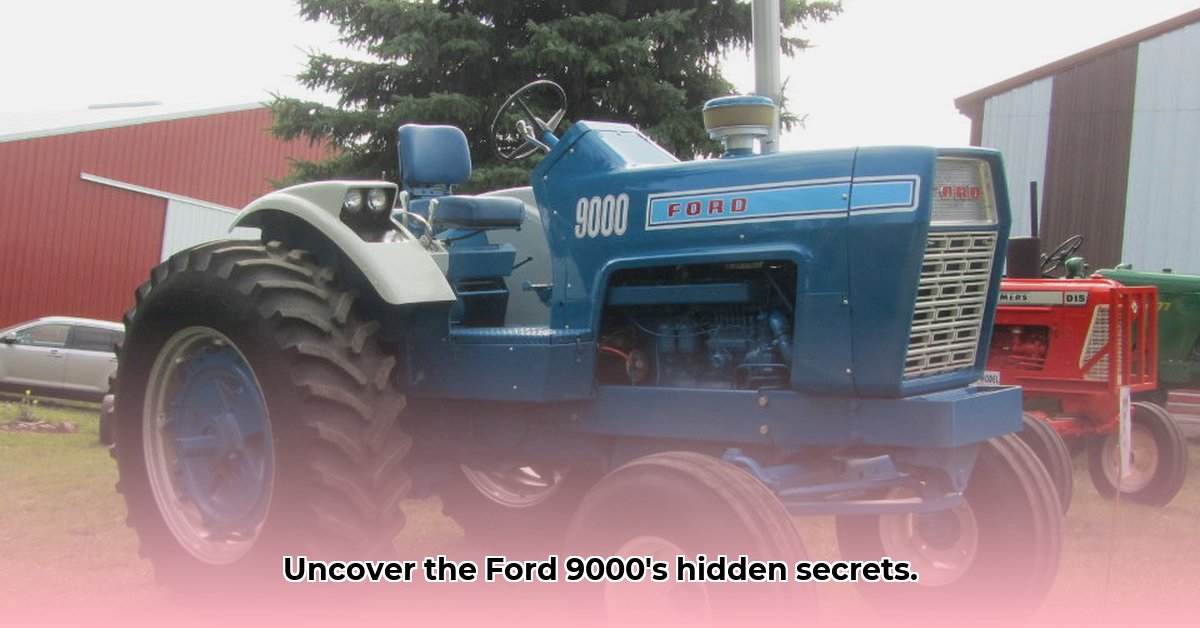
The Ford 9000 tractor, a powerhouse of the early 1970s, isn't just a piece of farm equipment; it's a coveted collectible, a testament to Ford's engineering prowess and a symbol of agricultural innovation. This comprehensive guide delves into the Ford 9000, providing insights for collectors, enthusiasts, and potential owners, covering everything from its powerful engine to the intricacies of transmission restoration. Whether you're a seasoned mechanic or a curious newcomer, this guide offers actionable intelligence for navigating the world of Ford 9000 ownership. For more on Ford tractors, check out this helpful resource: Ford tractor specs.
Tractor Ford 9000: A Collector's Deep Dive
Produced between 1970 and 1972, the Ford 9000 stands out as a significant milestone in agricultural machinery. But what makes it so desirable for collectors? Its robust design, powerful engine, and advanced transmission options for its time are key factors contributing to its lasting appeal. This section explores these details, along with crucial identification tips to ensure authenticity.
The Ford 9000's Mighty Engine: Power Under the Hood
At the heart of the Ford 9000 beats a robust 6.6-liter, six-cylinder diesel engine. While horsepower figures vary slightly in different sources (145-147 hp), its impressive 16.5:1 compression ratio speaks volumes about its power and torque. This engine's ability to handle demanding tasks, from plowing to hauling, is a major reason why the Ford 9000 remains a sought-after collectible. Isn't the raw power of this engine a key part of its enduring attraction?
Shifting Gears: The Ford 9000's Transmission
The Ford 9000 offered a choice between an 8-speed or a more advanced 16-speed power-shift transmission, a significant advancement for its era. The 16-speed version, with its four reverse gears, provided exceptional control and smooth shifting, enhancing both efficiency and operator ease. This advanced transmission system significantly improved upon the capabilities of competing tractors of the time.
Design and Features: Innovation Meets Practicality
Beyond its powertrain, the Ford 9000 incorporated several innovative features. Power steering significantly reduced operator fatigue, while a reliable hydraulic wet disc braking system enhanced safety. The optional cab, a luxury for the time, further boosted operator comfort. However, some design aspects, such as its open-center hydraulic system and the lack of four-wheel drive, represent notable differences compared to modern tractors and are frequently discussed among collectors.
Identifying a Genuine Ford 9000: Spotting the Real Deal
Authenticity is crucial for collectors. Begin by thoroughly verifying engine and transmission specifications against original documentation, such as brochures and owner's manuals. These often contain crucial serial numbers and identification markings. A careful inspection of its overall condition – checking for wear, modifications, or past repairs – helps determine its originality and authenticity.
Restoring and Maintaining Your Ford 9000: A Labor of Love
Restoring a Ford 9000 is a labor of love, demanding time, patience, and dedication. Sourcing original parts can be a challenge; establishing relationships with specialized vintage Ford parts suppliers is essential. Just as with a classic car, regular maintenance is crucial for longevity and preserving the tractor's value.
The Ford 9000's Legacy: A Significant Mark on Agricultural History
Despite its relatively short production run, the Ford 9000 left a significant mark on agricultural history. It represents a key transition in tractor technology, bridging the gap between older designs and the more advanced machines that followed. For collectors, it is a tangible connection to this pivotal period of agricultural innovation.
Actionable Steps for Aspiring Ford 9000 Collectors
Here's a step-by-step guide for collectors interested in acquiring a Ford 9000:
- Thorough Research: Research available models and their specifications to understand the variations.
- Meticulous Inspection: Carefully inspect potential purchases, noting any modifications or wear.
- Strategic Networking: Build relationships with specialized vintage Ford parts suppliers.
- Comprehensive Documentation: Meticulously document the tractor's history and maintenance records.
- Community Engagement: Join collector clubs or online forums for support and shared knowledge.
Weighing the Pros and Cons: Owning a Ford 9000 Tractor
Before investing, consider the following:
| Pros | Cons |
|---|---|
| Powerful and reliable engine | Parts sourcing can be challenging and time-consuming |
| Advanced transmission for its era | Relatively short production run limits parts availability |
| Historically significant and collectible | Restoration can be complex and expensive |
| Potential for appreciation in value | Requires specialized knowledge and mechanical skills |
How to Restore a Ford 9000 Tractor Transmission: A Detailed Guide
The Ford 9000's Dual Power transmission is a complex system requiring specialized knowledge for restoration. This section provides a step-by-step guide to restoring this crucial component.
Understanding the Ford 9000's Dual Power Transmission
The Dual Power transmission is a sophisticated interplay of mechanical and hydraulic components. Eight main gears, each with low-high range selection via hydraulically activated clutches, are controlled by foot-operated buttons. Smooth, distinct detents should accompany each shift; anything less indicates a problem.
Assessing the Damage: A Step-by-Step Approach
Before beginning repairs, a thorough inspection is crucial:
- External Inspection: Examine the linkage for wear, bending, or breakage.
- Hydraulic System Check: Inspect for leaks, low fluid levels, or contamination.
- Internal Examination: Carefully disassemble the transmission to assess internal components.
- Parts Sourcing: Connect with other enthusiasts and specialized suppliers to source replacement parts.
Repairing the Ford 9000 Transmission: Practical Tips
Repairing the transmission requires meticulous cleaning, precise reassembly, and patience.
- Gear Replacement: Replace worn or damaged gears using specialized tools.
- Bearing Replacement: Replace worn bearings for smooth operation.
- Hydraulic System Repair: Address leaks by replacing seals or repairing components.
- Linkage Adjustments: Adjust the linkage for smooth shifting after reassembly.
Preventative Maintenance: Keeping Your Transmission Healthy
Regular fluid changes and routine inspections are crucial for preventing major transmission issues. Proactive maintenance significantly extends the life of the transmission. This preventative approach will save time and money in the long run.